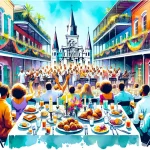Dixieland Jazz materialized as an energetic and influential musical style in the early 20th century in New Orleans. This jubilant and high-spirited form of jazz, distinguished by its collective improvisation and infectious rhythms, has become emblematic of the spirit of the Crescent City.
In This Article
TL;DR
- Dixieland Jazz showcases polyphonic improvisation, featuring a frontline of trumpet, clarinet, and trombone supported by a rhythm section.
- Pioneering artists like Louis Armstrong, Sidney Bechet, and Jelly Roll Morton played pivotal roles in shaping and popularizing Dixieland Jazz.
- Today, New Orleans continues to celebrate its Dixieland Jazz legacy through live performances at iconic venues and annual festivals.
The Birth of Dixieland Jazz
The early 20th century New Orleans music scene was a melting pot of diverse influences, including ragtime, blues, marches, and European classical music. African American and Creole musicians blended these elements to create a new, exciting sound that would later be known as Dixieland Jazz.
The unique cultural dynamics of New Orleans, with its lively nightlife and musical traditions, provided the perfect environment for this new genre to flourish. Dance halls, saloons, and even street corners became stages for the early jazz bands, who entertained audiences with their spirited and improvisational performances.
Key Figures in Dixieland Jazz
Several pioneering musicians left an indelible mark on the development and popularity of Dixieland Jazz. Louis Armstrong, a native of New Orleans, is widely regarded as one of the most influential figures in jazz history. His virtuosic trumpet playing and innovative improvisational style set the standard for generations of jazz musicians to come.
Other notable figures include Sidney Bechet, a master clarinetist known for his powerful and expressive playing, and Jelly Roll Morton, a pianist and composer who claimed to have invented jazz. Their contributions, along with those of countless other musicians, helped shape the sound and spirit of Dixieland Jazz.
Musical Characteristics of Dixieland Jazz
Dixieland Jazz bands typically feature a frontline of trumpet (or cornet), clarinet, and trombone, supported by a rhythm section consisting of piano, banjo or guitar, bass or tuba, and drums. This instrumentation allows for a lively and polyphonic sound, with each instrument contributing to the collective improvisation.
The structure of a Dixieland tune often follows a standard format, with an opening ensemble section, followed by individual solos from the frontline instruments, and a closing ensemble section. Improvisation is at the heart of Dixieland Jazz, with musicians creating spontaneous variations on the melody and interacting with one another in a musical dialogue.
Dixieland Jazz and New Orleans Culture
Dixieland Jazz is deeply intertwined with the cultural fabric of New Orleans. The genre has played a significant role in the city’s famous Mardi Gras celebrations, with brass bands parading through the streets and providing the soundtrack to the festive atmosphere.
The music also reflects the broader cultural dynamics of New Orleans, a city known for its vibrant African American and Creole communities, as well as its French, Spanish, and Caribbean influences. Dixieland Jazz embodies this rich cultural fusion, creating a sound that is uniquely New Orleans.
Evolution of Dixieland Jazz
Over the decades, Dixieland Jazz has undergone various changes and adaptations. As jazz evolved and new styles emerged, such as swing and bebop, Dixieland Jazz incorporated elements of these genres while maintaining its distinctive character.
Technological advancements, such as the introduction of the microphone and the rise of radio and recording industries, also had an impact on the genre. These developments allowed Dixieland Jazz to reach a wider audience and helped to preserve the music for future generations.
Current Dixieland Jazz Scene in New Orleans
Today, New Orleans continues to celebrate its Dixieland Jazz heritage through live performances at iconic venues and annual festivals. Preservation Hall, located in the heart of the French Quarter, is a renowned venue dedicated to preserving and promoting traditional New Orleans jazz. The hall hosts nightly concerts featuring some of the city’s finest Dixieland Jazz musicians.
Other popular venues for Dixieland Jazz include the Palm Court Jazz Cafe, Fritzel’s European Jazz Club, and the Spotted Cat Music Club. These establishments offer visitors the opportunity to experience the music in intimate settings, often with a side of authentic New Orleans cuisine.
Participating in Dixieland Jazz Today
For those interested in experiencing Dixieland Jazz live, New Orleans offers numerous opportunities. The best times to visit are during the city’s major music festivals, such as the New Orleans Jazz & Heritage Festival (held annually in late April and early May) and the French Quarter Festival (usually held in April).
Visitors can also take part in jazz-themed walking tours, which provide insights into the history and culture of Dixieland Jazz while exploring the city’s musical landmarks. Many of these tours include live performances and the opportunity to interact with local musicians.
Preserving Dixieland Jazz
Efforts to preserve and promote Dixieland Jazz in New Orleans are ongoing. Organizations such as the New Orleans Jazz Museum and the New Orleans Jazz National Historical Park work to educate the public about the genre’s history and significance through exhibits, performances, and educational programs.
The city also supports the next generation of Dixieland Jazz musicians through initiatives like the Preservation Hall Foundation’s “Teach the Beat” program, which provides music education and mentorship to young aspiring artists. These efforts ensure that the legacy of Dixieland Jazz will continue to thrive in New Orleans for years to come.
Dixieland Jazz remains a vital and cherished part of New Orleans’ musical heritage. Its infectious rhythms, collective improvisation, and joyous spirit continue to captivate audiences and inspire new generations of musicians. By exploring the history, culture, and current scene of Dixieland Jazz in New Orleans, visitors and enthusiasts can immerse themselves in the rich tapestry of this timeless genre.






